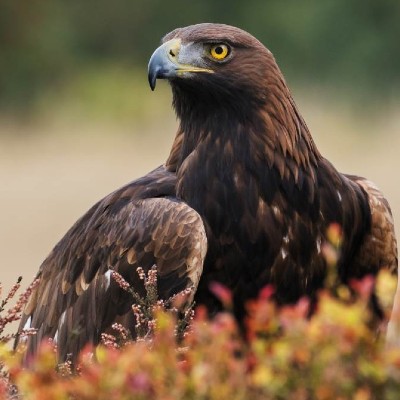Golden eagle - Aquila chrysaetos
Name: Aquila chrysaetos – golden eagle
Appearance: Their feathers are blackish-brown or brown, with golden colour on the back of their heads and necks, which is how they got their name. Cubs look like mature individuals but they have white tail and white patches at their ankle. These gradually reduce in size with each moulting to completely disappear in their age of five. The head is relatively small, and the tail is big. On the head, there is a strong beak which is bent down. On their strong legs, there are 4 toes, 3 are pointed in front and one in back. There are big and strong claws on their toes.
Body length: 66-100 cm
Wingspan: 150-240 cm
Body weight: 2.5-6.5 kg
Nutrition: carnivore
Number of eggs laid: 2, usually only one young bird survives
Golden eagle is one of the biggest birds of prey in the Dinarides. The population in Europe is estimated at about 9 300 – 12 300 of nesting couples (BirdLife International, 2015).
It usually lives in the mountain areas but that is a consequence of the fact that man pushed it out of the open areas.
It flies graciously and high, often gliding long. They are remarkably powerful and fast birds. The speed of their flight can reach up to 240 km/h. When hunting, they rely on their speed and good vision, which is eight times sharper than man’s. They have a sharp vision because they have big pupils that ensure minimal light scattering, which enables noticing their prey from a long distance.
They usually hunt in pairs. While one bird is after its prey, the other is waiting in ambush. They catch their prey with strong, powerful legs with sharp claws. They use their claws for killing and carrying their prey, and the beak is used for dismembering it. Same as hunting in pairs, they jointly eat the dismembered prey. The hunt usually lasts until noon. Golden eagles feed on almost every animal they can catch: mice, rabbits, martens, foxes, other birds and, from time to time, they also catch a fawn, a lamb or a kid. During the winter, in the absence of food, they can also feed on carcases.
Golden eagles usually stay with the same partner throughout their lives. They build a few nests on their territory, using them for several years, usually on rocks and cliffs of high mountains or on high trees. They make their nests from twigs and grass. Their nests can be up to 2 m in diameter and 1 m in height. The female lays two eggs in the nest, which is usually on an inaccessible cliff. She broods on eggs for 45 days after which two completely white birds are hatched. Usually only the elder one survives because it grows more and fights for more food in the nest. It is very common that the elder one kills the younger, weaker one. The mortality among little birds is very big and, any of them dies in the first weeks of their lives. If surviving the first year of its life, the young bird becomes independent and finds its territory with 3 – 4 years of age.
Golden eagles have very few natural enemies so they live long, even up to 30 years. Nowadays, their biggest threat is man, or the loss of their natural habitats, lack of food, hunt, poisoning, electrocutions and collisions with wind farms.

